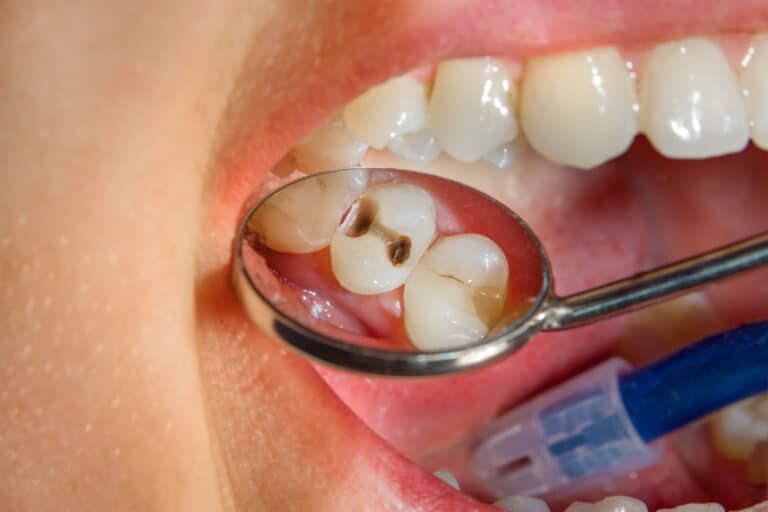Teeth are a critical part of your facial structure and not just in terms of being able to eat. They help facilitate proper speech and breathing and ensure the bones of the jaw and facial plates remain strong and healthy. Tooth loss and decay can put your normal oral function at risk and even cause long-term problems in your overall health, including increasing your chance of developing conditions like Alzheimer’s, diabetes, rheumatoid arthritis, cancer, and heart disease.
Tooth decay is highly preventable, but nearly 90% of adults between the ages of 20 and 64 and 96% of adults between age 50 and 64 experience some degree of tooth decay every year. This makes education, prevention, and treatment of tooth decay increasingly important.
Tooth decay is caused by the accumulation of bacteria in your mouth. When this bacteria isn’t removed–such as through brushing and flossing–it feeds on food particles and residue and begins to form plaque and tartar, sticky substances that trap acids against the enamel of the teeth. This trapped acid begins to eventually eat away at the enamel, providing an opening for more bacteria to penetrate the softer inner tissues of the teeth and cause decay and infection.

Tooth decay is a gradual process that worsens over time if not treated as soon as possible. There are five stages of tooth decay:
You cannot reverse decay, especially decay that has progressed beyond demineralization, because, unlike skin, hair, and other parts of the body, enamel doesn’t regrow. Once tooth decay has penetrated the enamel, it cannot be reversed, only treated.
However, you can halt or improve the early-stage condition of weakened enamel with improved oral hygiene, a healthy diet, and fluoride treatments. At this stage, before decay has started to eat away at enamel, you can strengthen the enamel you have left and prevent further damage.
The treatment option for tooth decay depends on the stage and severity of decay. Early decay is primarily treated with fluoride treatments, and cavities can be addressed with fillings. If your decay is more advanced and the bacteria has progressed beyond the dentin and into the pulp, you likely need crowns or even root canals. These treatments remove all signs of infection and help restore the strength and integrity of your tooth.
If the decay cannot be treated with a root canal, then your only option may be extraction. Extractions are recommended only as a last resort, when the tooth has decayed too much and cannot be salvaged. Following an extraction, you may then need some kind of restoration, such as dental implants, a bridge, or dentures.
While tooth decay is common, it doesn’t have to be inevitable. However, because tooth decay can’t be reversed, the best thing you can do for your oral health is to prevent it in the first place.
Lifestyle habits and good oral hygiene are some of the simplest ways to protect your teeth from decay. Brushing and flossing at least twice a day is the baseline, and it’s a great habit to take a drink of water or even rinse your mouth after you’ve eaten something sweet. Additionally, a healthy diet that is lower in refined sugars and carbs and higher in produce, protein and natural sugars helps your body function properly, from producing sufficient saliva to cutting down on the bacterial feeding grounds in your mouth. Choose toothpaste with fluoride, and schedule regular dental check-ups every six months to get the extra help from fluoride treatments and a thorough cleaning. If you smoke or use chewing tobacco or other nicotine products, you should consider stopping.
There are an array of dental and oral hygiene products available that can help give good daily habits an added boost for better prevention. Numerous studies have shown that manual toothbrushes do not clean as effectively as automatic ones, so you may consider investing in a battery-powered toothbrush. Choose toothpaste that focuses on remineralizing weakened areas, because this provides the mouth with the minerals your enamel needs to stay strong, and consider adding a mouthwash with fluoride for added protection.
When combined with routine cleanings and exams, dental treatments like fluoride and dental sealants can play a big role in preventing tooth decay and reversing early demineralization. Fluoride and dental sealants can help keep decay from happening, especially in patients who are at a higher risk of developing decay, while regular cleanings and x-rays can help your dentist catch decay in its early stages, when it’s most treatable.
Preventing tooth decay takes more than just basic brushing. At Dental Depot, we provide the comprehensive dental services you and your family need to enjoy a beautiful, healthy smile for a lifetime. From fluoride treatments and dental sealants to fillings, crowns, and restorations, you’ll find everything you need at any of our locations, and all at a commonsense price. We work hard to make getting the care you deserve easy, fun, and affordable, so that’s why we offer plenty of payment and financing options, Saturday appointments, and large treatment bays that are fully staffed, so we can see everyone in your family at the same time.
Don’t wait to start taking the right steps to preventing tooth decay. Schedule an appointment with Dental Depot today to protect your oral health for tomorrow!